 Crime
Crime  Crime
Crime  History
History 10 Facts about the Last Man to Be Hanged for Treason in the UK
 Movies and TV
Movies and TV 10 Actors Who Returned to Roles after a Long Absence
 Animals
Animals 10 Clever Creatures That Don’t Have a Brain
 Crime
Crime 10 Evil Pastors Who Killed Their Family
 Politics
Politics 10 Politicians Who Beat a Future President
 Sport
Sport 10 Wild Facts about the Crazy First Years of the Tour de France
 Movies and TV
Movies and TV 10 Great Songs by Fictional Musicians in Movies
 Animals
Animals Ten Astonishing Stories about Underwater Life
 Weird Stuff
Weird Stuff 10 Strange and Unexpected Things Smuggled into Strict Authoritarian Countries
 Crime
Crime 10 Startling Cases of Jurors’ Mischief
 History
History 10 Facts about the Last Man to Be Hanged for Treason in the UK
 Movies and TV
Movies and TV 10 Actors Who Returned to Roles after a Long Absence
Who's Behind Listverse?

Jamie Frater
Head Editor
Jamie founded Listverse due to an insatiable desire to share fascinating, obscure, and bizarre facts. He has been a guest speaker on numerous national radio and television stations and is a five time published author.
More About Us Animals
Animals 10 Clever Creatures That Don’t Have a Brain
 Crime
Crime 10 Evil Pastors Who Killed Their Family
 Politics
Politics 10 Politicians Who Beat a Future President
 Sport
Sport 10 Wild Facts about the Crazy First Years of the Tour de France
 Movies and TV
Movies and TV 10 Great Songs by Fictional Musicians in Movies
 Animals
Animals Ten Astonishing Stories about Underwater Life
 Weird Stuff
Weird Stuff 10 Strange and Unexpected Things Smuggled into Strict Authoritarian Countries
10 Fascinating Facts About Marine Life
As most people know, about 70 percent of the Earth’s surface is covered in water. All said and done, there’s about 1.3 billion cubic kilometers (332.5 million cubic miles) of water on the planet, and the seas and rivers and oceans that hold all that water are still some of the most poorly understood regions on Earth—and so are the creatures that live in them.
10 Colossal Squid Digest Food With Their Brains
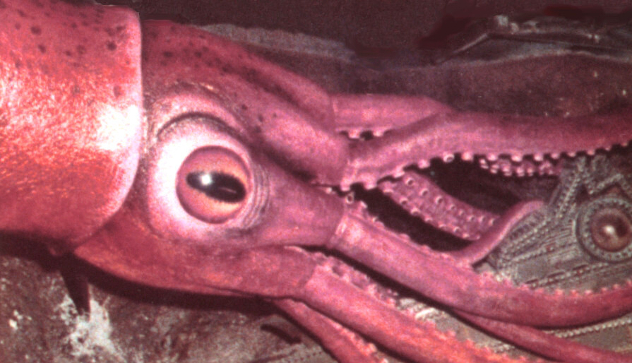
The colossal squid, or Mesonychoteuthis hamiltoni, was believed to be a myth until recently, and we’ve still only seen a handful in real life. In 2007, the largest specimen yet was found and captured by a crew of New Zealand fishermen in the Ross Sea near Antarctica. It was massive—a full 10 meters (33 ft) long and almost 450 kilograms (1,000 lbs) in weight. The squid was hauled back to New Zealand to be studied, and they found something pretty incredible: Its digestive system runs right through the center of its brain.
The brain is built like a doughnut—a ring of fleshy mass with a hole right in the middle. When the colossal squid swallows its prey, the esophagus carries it through the brain, which pulls nutrients directly from the food before it reaches its stomach. Gigantic squid like this inhabit the frigid waters of the deep ocean, and between the cold and their ridiculously slow metabolisms, they don’t actually need much food to survive. In fact, the half-ton animal only needs 30 grams (1 oz) of food per day to survive. That’s about what a single AA battery weighs.
9 Piranha-Proof Fish Armor
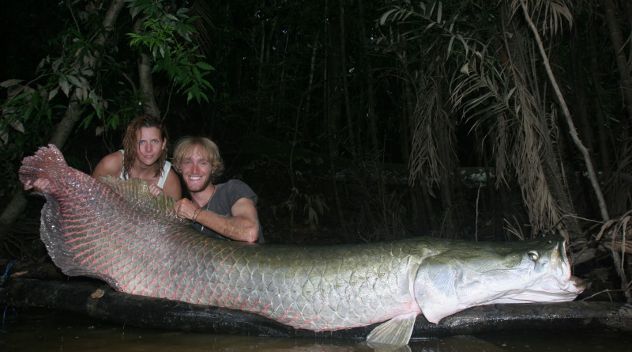
Piranhas, the razor-toothed terrors of the Amazon River, have few natural predators and an almost endless buffet of potential prey. Although a single piranha might make a nice meal for a dolphin or a cormorant, their tendency to swim in schools of hundreds keeps most predators at bay, so piranhas live a largely lawless life. As a result, other Amazonian fish have had to adapt to their bullying neighbors, and even the largest fish in the Amazon—the Arapaima gigas or giant arapaima—needs a second layer of protection.
Giant arapaima are massive fish, weighing close to 130 kilograms (300 lbs) at adulthood. But as Teddy Roosevelt observed, a school of piranhas won’t shy away from size alone, so the giant arapaima evolved armor to withstand the bites. Their scales are built in two layers—the outer layer is a hard, mineralized surface shell, and the inner layer is softer with intricate collagen structures built like rotating stairways. When a piranha’s tooth clamps against the outer shell, the stairway structures bend and rotate to absorb the force without breaking. It’s like punching a pillow rather than a pane of glass—the pillow bounces back into shape.
8 Invisible Warfare

The most abundant lifeform in the ocean is one you’ll never see—a family of bacteria collectively known as SAR11. They live in all the world’s oceans from the arctic to the tropics, and they’re incredibly efficient at their job—converting dissolved carbon into CO2. The most abundant predator in the ocean also exists at the microscopic level—a closely related group of viruses called pelagiphages. And they’re waging holy war on the SAR11 bacteria.
What’s happening is a fiercely competitive evolutionary arms race. Twenty-three years ago, in 1990, the SAR11 bacteria were observed for the first time, and they weren’t given a lot of attention. They don’t do much; there just happen to be a lot of them. But earlier this year, a routine test of the water off the coast of Oregon found a mass of dead SAR11 cells. Swimming in the same water were the previously unknown pelagiphage viruses, and the researchers watched as the viruses murdered the remaining bacteria cells in front of their eyes.
But the SAR11 are so adept at sharing genetic information that they’ve managed to stay one step ahead of the pelagiphages, constantly evolving to fight them off. And the viruses aren’t far behind. There’s already a completely new subfamily of pelagiphage viruses, evolved to prey on the more evolved SAR11 cultures. It’s a microscopic war unfolding right in front of us.
7 Catfish Have About 100,000 Taste Buds

Humans have somewhere between 2,000 and 8,000 taste buds, all concentrated on the little lump of flesh wiggling around your mouth. Catfish, on the other hand, have closer to 100,000 individual taste buds—all over their bodies. In a sense, a catfish is just a big swimming tongue. Each taste bud is about 50 nanometers (50 billionths of a meter, or 164 billionths of a foot) wide, and the bigger the fish is, the more taste buds it has. Larger fish can have more than 175,000 taste buds dotted across their body.
Why would an animal—especially one that lives in the mud at the bottom of murky ponds—need such a strong sense of taste? They use it to hunt. Visibility becomes more limited the deeper you go, so for a bottom dweller like the catfish, sight isn’t always helpful. With their taste buds, catfish can “taste” prey meters away, like a wolf catching a scent. And with so many buds all over their body, they can essentially triangulate the prey’s location based on how strongly the taste hits certain body parts. Most of the taste buds are clustered around the fore region of the catfish so it can home in on the prey once it’s angled in the right direction.
Catfish still use their eyes, but researchers have found that the taste buds are more important for hunting than sight. Take away a catfish’s eyes and it will still find food. Take away its taste buds, however, and it’s essentially blind.
Photo credit: Lukas Jurek
6 Dolphins Can See Through Animals

Dolphins, as everybody knows, use sonar to navigate through the water, hunt, communicate, and do just about everything. Known as echolocation, dolphin sonar involves high frequency bursts of sound created by forcing air through a network of tissues near their blowholes. A sac of fatty tissue below their jaws collects the rebounding sound waves and sends them through the dolphin’s inner ear, where the information is passed on to the brain, creating an “acoustical holographic image,” or a picture of the ocean in front of them.
The high frequency of the echolocation bursts—40–130 kHz—isn’t well suited for traveling long distances through the water, but its shorter wavelength is perfect for penetrating soft objects. In other words, it travels through the soft bodies of other fish and dolphins and only reflects from the hard surfaces—bones and cartilage. In other (other) words, it functions like X-ray vision, allowing the dolphin to see into other animals. Based on dolphin behavior (especially in bottlenose dolphins), it’s believed that dolphins can peer into shark stomachs to see when they’re full, or to see when a female is pregnant. Dolphins have also been observed clicking along the seabed to spot hidden fish buried in up to 1 meter (3 ft) of sand.
5 Swellsharks
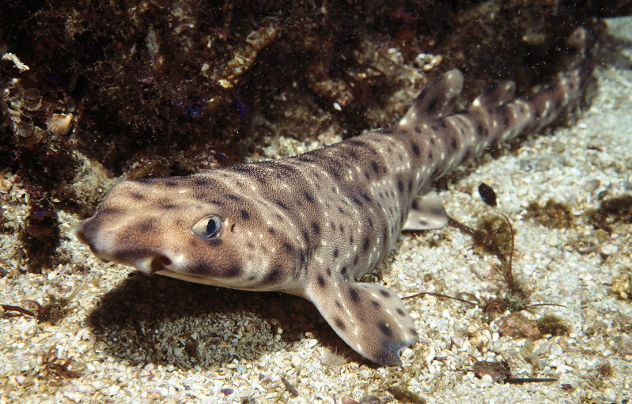
Most sharks scare away predators simply by being, well, sharks. However, they do still have predators, and the smaller the shark species, the more predators there are. The swellshark is one of the smaller breeds, only growing to about 1 meter (3 ft) long, roughly the size of a small doberman. Swellsharks are bottom feeders, preferring to ambush crabs and unsuspecting cuttlefish over the risky thrill of chasing normal fish. An adventurous day means stealing lobsters from a lobster trap. And as far as defenses go, the swellshark is a master of disguise: When it’s threatened, it sucks water into sacs that curve around its belly, swelling up to twice its normal size.
But then it does something even weirder—it bends its body into a crescent, grabs its tail in its mouth, and turns itself into a big, inflated ring. The result is something that’s just . . . hard to eat. And since swellsharks normally lurk in rocky crevices, the swelling effectively wedges them into their hiding spots. So even if a fish gets a hold of them, it won’t be able to pull out anything larger than a mouthful. It’s often referred to as the most awkward shark in the world.
4 Pompeii Worms Have A Living Shield

“The hottest animal on the planet, but the most difficult to study,” is how the Pompeii worm, or Alvinella pompejana, has been described. Not only do these worms live 2,500 meters (8,000 ft) below the ocean’s surface on volcanic vents that heat the surrounding water to 80 °C (176 °F), they also have an annoying tendency to die when brought to the surface. For a long time, Pompeii worms were believed to be the most heat-tolerant animals on the planet. They grow to about 13 centimeters (5 in) long and live in tubes attached directly to the sides of “black smokers,” smoke-belching exhaust vents on the floor of the East Pacific Rise.
However, their claim to fame has been called into question. Using pressurized capsules, researchers managed to bring a few of the worms up to a lab and found that after 10 minutes of exposure to temperatures of 50 °C (122 °F), the worms died and their tissues hardened like a boiled egg—they were cooked. But the fact remained that Pompeii worms did indeed live in these temperatures, so they took a closer look and found that a layer of bacteria normally lived around the worms. They had a living shield that absorbed part of the heat from the scalding water like a fireman’s blanket. In return, the worms were producing a mucous layer that fed the bacteria—a perfect symbiosis.
3 Anguilla Eels Can Walk On Land
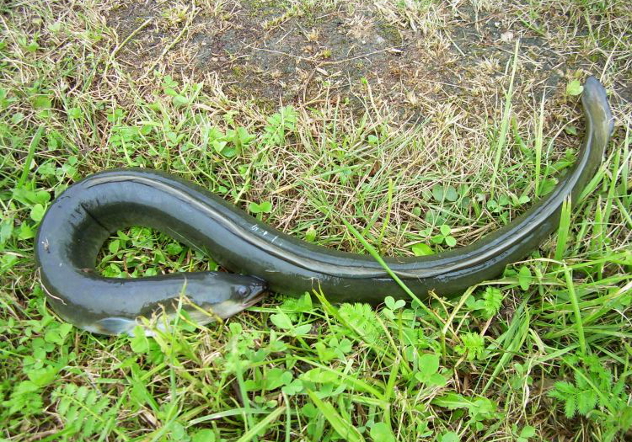
Anguilla eels, commonly known as European eels, live in the lakes and waterways of northern Europe and the UK. They’ve been recorded at lengths of nearly 2 meters (6.5 ft), though they’re normally only about half that size or smaller. But they don’t always stay where they’re supposed to—Anguilla eels can leave the water and slither across dry land for a short amount of time. They do this for two reasons—the first is to feed, although they usually stick to insects and earthworms. The second reason is to migrate.
Anguilla eels spend about 20 years in the same lake. But they start and end their lives 6,500 kilometers (4,000 mi) across the Atlantic in the Sargasso Sea. To get from their European lakes to the Atlantic, anguillas work their way up and down waterways using an as-yet-undiscovered navigation system. If the waterway is blocked—with a dam, for example—the eels leave the water and cross fields and forests to the next stream or river. Environmentalists are actually using that unique ability to build climbable “ladders” on dams and weirs to allow the eels to complete their migrations. On a slightly more terrifying note, the larger cousins of anguillas, conger eels, can also cross dry land, and also have the tendency to attack people.
2 The World’s Largest Migration Happens Every Day
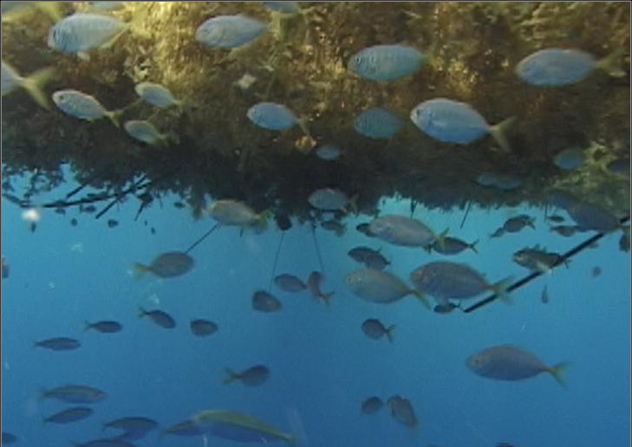
The Sargasso Sea is perhaps the most unique body of water in the world. It doesn’t have any borders other than a series of converging currents that hold it roughly in the same place, even though it’s right in the middle of the Atlantic Ocean. It’s a body of water within a body of water—the Gulf Stream, the North Atlantic Current, and the Canary Current all hit it on different sides, with the Sargasso Sea acting as the calm center. It was called the “Sea of Lost Ships” by sailors because the air is unnaturally calm and ships could get stuck there for days or weeks.
Most importantly, the Sargasso Sea is an almost completely self-sufficient ecosystem. The sargassum, a floating seaweed that covers the surface of the sea, provides food and shelter for thousands of species, which in turn provide food for the sargassum through their waste. There are layers upon layers of marine life in the sea, from surface dwellers to deep-sea life over 5000 meters (16,000 ft) down. And at night, it’s the setting for the largest migration in the world—over 5,000 species comprising millions of sea creatures surge up from the deep to feed, then return to the bottom before dawn.
Photo Credit: NOAA
1 Google Street View: Oceans
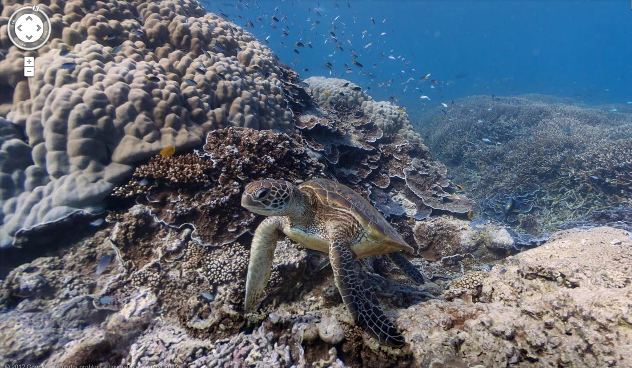
Google Street View is a popular addition to Google Maps that lets you look at any location from street level. In 2007, Google sent a fleet of cars around the world to photograph literally everything. Then they took the photos and composited them into a long string that lets you “walk” any route with the click of a button. But that’s old news and hardly exciting.
Street View: Oceans is sort of the same thing, except instead of looking at your ex-girlfriend’s house you can stroll directly into the Great Barrier Reef, or any one of dozens of underwater spots spread across six oceans. They’re adding more locations to the program as fast as they can, but so far they only have the reefs around the Galapagos Islands, Heron Island, Wilson Island, and Hanauma Bay, to name a few. This is part publicity stunt and part science project—while anyone can enjoy the tour, they’re also using the photos to monitor the growth (and decay) of the world’s most important coral reefs, which provide a combined home for a full 25 percent of all marine life.








